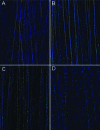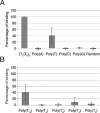Guanine quadruplex monoclonal antibody 1H6 cross-reacts with restrained thymidine-rich single stranded DNA
- PMID: 28449085
- PMCID: PMC5449594
- DOI: 10.1093/nar/gkx245
Guanine quadruplex monoclonal antibody 1H6 cross-reacts with restrained thymidine-rich single stranded DNA
Abstract
Previously we reported the production and characterization of monoclonal antibody 1H6 raised against (T4G4)2 intermolecular guanine quadruplex (G4) DNA structures (Henderson A. et al. (2014) Nucleic Acids Res., 42, 860-869; Hoffmann R.F. et al. (2016) Nucleic Acids Res., 44, 152-163). It was shown that 1H6 strongly stains nuclei and has exquisite specificity for heterochromatin by immuno-electron microscopy. Here we extend our studies of 1H6 reactivity using enzyme-linked immunosorbent assay (ELISA) and microscale thermophoresis (MST). As previously reported, 1H6 was found to strongly bind intermolecular G4 structures with a (T4G4)2 sequence motif. However, using both methods we did not detect significant binding to G4 structures without thymidines in their sequence motif or to G4 structures made with (T2G4)2 oligonucleotides. In addition, we observed strong, sequence-specific binding of 1H6 by ELISA to immobilized single stranded poly(T) DNA but not to immobilized poly(C) or poly(A) homo-polymers. Cross-reactivity of 1H6 to poly(T) was not measured in solution using MST. 1H6 was furthermore found to bind to selected areas on DNA fibers but only after DNA denaturation. Based on these observations we propose that 1H6 binds with high affinity to adjacent T's that are restricted in their movement in selected G4 structures and denatured DNA. Cross-reactivity of 1H6 to immobilized single stranded T-rich DNA next to its previously reported specificity for bona fide G4 structures needs to be taken into account in the interpretation of 1H6 binding to (sub-) cellular structures.
© The Author(s) 2017. Published by Oxford University Press on behalf of Nucleic Acids Research.
Figures




Similar articles
-
Guanine quadruplex structures localize to heterochromatin.Nucleic Acids Res. 2016 Jan 8;44(1):152-63. doi: 10.1093/nar/gkv900. Epub 2015 Sep 17. Nucleic Acids Res. 2016. PMID: 26384414 Free PMC article.
-
Detection of G-quadruplex DNA in mammalian cells.Nucleic Acids Res. 2014 Jan;42(2):860-9. doi: 10.1093/nar/gkt957. Epub 2013 Oct 24. Nucleic Acids Res. 2014. PMID: 24163102 Free PMC article.
-
[Generation and characterization of the monoclonal antibody and scFv against yeast telomeric guanine-quadruplex DNA].Fen Zi Xi Bao Sheng Wu Xue Bao. 2006 Oct;39(5):482-8. Fen Zi Xi Bao Sheng Wu Xue Bao. 2006. PMID: 17117561 Chinese.
-
[The cellular functions of G-quadruplex in neurological diseases].Nihon Yakurigaku Zasshi. 2022;157(3):182-186. doi: 10.1254/fpj.21116. Nihon Yakurigaku Zasshi. 2022. PMID: 35491115 Review. Japanese.
-
G-quadruplexes and helicases.Nucleic Acids Res. 2016 Mar 18;44(5):1989-2006. doi: 10.1093/nar/gkw079. Epub 2016 Feb 15. Nucleic Acids Res. 2016. PMID: 26883636 Free PMC article. Review.
Cited by
-
Parallel G-quadruplexes recruit the HSV-1 transcription factor ICP4 to promote viral transcription in herpes virus-infected human cells.Commun Biol. 2021 Apr 30;4(1):510. doi: 10.1038/s42003-021-02035-y. Commun Biol. 2021. PMID: 33931711 Free PMC article.
-
BG4 antibody can recognize telomeric G-quadruplexes harboring destabilizing base modifications and lesions.Nucleic Acids Res. 2024 Feb 28;52(4):1763-1778. doi: 10.1093/nar/gkad1209. Nucleic Acids Res. 2024. PMID: 38153143 Free PMC article.
-
Mechanism of the feedback-inhibition resistance in aspartate kinase of Corynebacterium pekinense: from experiment to MD simulations.RSC Adv. 2020 Dec 22;11(1):30-38. doi: 10.1039/d0ra09153g. eCollection 2020 Dec 21. RSC Adv. 2020. PMID: 35423034 Free PMC article.
-
Detection of G-quadruplex DNA in mammalian cells.Nucleic Acids Res. 2017 Jun 2;45(10):6252. doi: 10.1093/nar/gkx300. Nucleic Acids Res. 2017. PMID: 28449109 Free PMC article. No abstract available.
-
G-Quadruplex Structures Colocalize with Transcription Factories and Nuclear Speckles Surrounded by Acetylated and Dimethylated Histones H3.Int J Mol Sci. 2021 Feb 17;22(4):1995. doi: 10.3390/ijms22041995. Int J Mol Sci. 2021. PMID: 33671470 Free PMC article.
References
-
- Sen D., Gilbert W.. Guanine quartet structures. Methods Enzymol. 1992; 211:191–199. - PubMed
MeSH terms
Substances
LinkOut - more resources
Full Text Sources
Other Literature Sources
Research Materials

